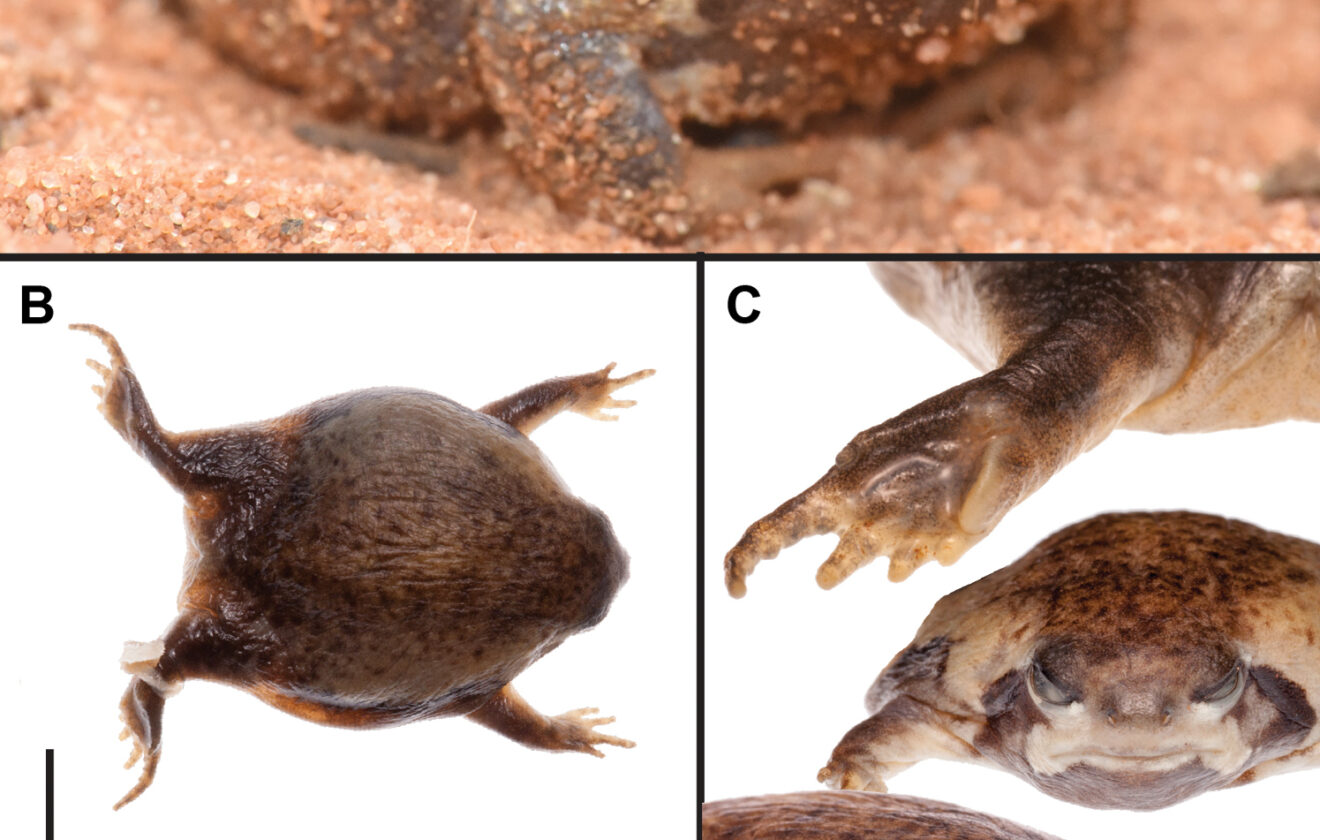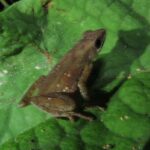Discovering Breviceps ombelanonga: The Remarkable Desert Rain Frog#
In the seldom-visited sands of northwestern Namibia, tucked amid dunes sculpted by ancient winds and sparse coastal vegetation, lives a peculiar and enchanting amphibian: Breviceps ombelanonga. Often referred to as the Desert Rain Frog, this small, enigmatic creature has captured the hearts and scientific curiosity of nature enthusiasts and biologists alike. With its unusual appearance, distinctive calls, and remarkable adaptations to a harsh, arid landscape, B. ombelanonga stands as a testament to life’s resilience and adaptability.
First described scientifically in 2020, Breviceps ombelanonga is a recent addition to the known biodiversity of our planet. Yet, in the unforgiving sands of Namibia, it has flourished quietly for millennia, hidden from human eyes. The frog’s discovery underscores the importance of exploration and conservation, reminding us that our world’s hidden corners still teem with incredible creatures awaiting acknowledgment and protection.
Taxonomy and Classification#
The scientific community recognizes Breviceps ombelanonga as part of the Brevicipitidae family, commonly known as the rain frogs. This family encompasses species well-adapted to a variety of unique and often challenging habitats across sub-Saharan Africa. Within this intriguing family, the genus Breviceps stands apart due to its notably diminutive size, round and chubby appearance, and distinctive vocalizations.
The species ombelanonga, derived from local terminology meaning “unique” or “distinctive,” specifically highlights its remarkable difference from closely related frogs. It shares genetic and physical traits with other desert-adapted frogs in the Breviceps genus but is entirely unique in its geographic adaptation to Namibia’s coastal deserts. Taxonomically, the identification of B. ombelanonga opened doors for further inquiries into adaptive radiation and evolution within amphibians inhabiting arid environments.
Natural Habitat#
Breviceps ombelanonga inhabits a specialized niche within the coastal Namib Desert, primarily in vegetated sandy dunes characterized by dense fog and sparse rainfall. Unlike their rainforest or freshwater cousins, these frogs have evolved remarkable adaptations for desert life. They reside primarily within a narrow strip extending along the northwestern Namib Desert coastline in southern Africa, where moisture arrives mainly through dense sea fog rather than rainfall.
This habitat, surprisingly hospitable considering limited rainfall, offers the frog sanctuary through a delicate balance of environmental factors. The frog thrives by burrowing beneath the sandy substrate, relying on cooler underground microclimates and nightly fogs to hydrate and maintain body moisture. Vegetation like succulent creepers and small shrubs play a critical role, stabilizing sandy dunes and providing vital shelter and moisture-rich food sources in the form of invertebrates.
The Namib Desert’s coastal belt is globally unique, representing one of the most fascinating ecosystems on earth—where aquatic moisture carries inland to nourish an otherwise barren landscape. Within this strange yet wondrous environment, the Desert Rain Frog forms part of a closely-connected lifecycle dependent on breezes, fog, sand formations, and sparse but critical plant life.
Physical Characteristics#
At first glance, Breviceps ombelanonga may seem whimsical, an endearing caricature sculpted by nature. Measuring only about 3–5 centimeters in length, the Desert Rain Frog presents itself as startlingly round-bodied, almost spherical—an adorable globe-shaped amphibian endowed with short, stumpy legs and proportionately oversized eyes lending it a perpetually astonished appearance.
Its skin exhibits a sandy coloration mottled with darker brown or grey patterns, conferring exceptional camouflage amidst the dunes. A characteristic feature is its semi-transparent underside, through which internal organs can sometimes be faintly discerned. This unique trait may help in thermoregulation and even moisture retention—a survival mechanism invaluable in arid ecosystems.
The physical attributes extend beyond mere aesthetics, revealing remarkable evolutionary strategies. Its rotund physique reduces surface area relative to body volume, effectively minimizing water loss, a critical adaptation in a habitat marked by scarcity. This tiny body is perfectly suited to digging quickly and effortlessly into soft, sandy substrates, offering rapid escape from predators and the unforgiving desert climate.
Behavior and Life Cycle#
Unusual Vocalizations and Communication#
Perhaps no behavior better epitomizes Breviceps ombelanonga than its unique and utterly arresting vocalizations. Unlike many other frog species, which emit croaks or ribbits, the Desert Rain Frog vocalizes high-pitched, distinctly squeaky cries more akin to a squeaking toy than to an amphibian call. Males utilize these characteristic calls to proclaim territory and attract receptive females, often vocalizing from burrows scattered amongst vegetative cover.
Feeding Habits and Foraging Patterns#
Primarily nocturnal, the Desert Rain Frog emerges from its shallow subterranean refuges under cover of darkness. Equipped with sensitive skin and keen eyesight adapted to the dim desert night, it actively searchers the sands for ants, termites, beetles, and other small invertebrates. Its diet fulfills essential nutrients but also indirectly assists in regulating insect populations, aiding ecological balance within this fragile desert ecosystem.
Mating, Egg-laying, and Parental Care#
Mating and reproduction coincide characteristically with humidity increases, typically during nights following heavy fog events. Unlike other frog species that deposit eggs into water bodies, Breviceps ombelanonga lays clusters of jelly-like eggs within moist subterranean nests—a critical advantage given the species’ absence of standing freshwater habitats.
Remarkably, the Desert Rain Frog exhibits attentive parental guarding behavior. Females remain in close proximity to eggs, vigilantly defending them from predators and dehydration until they hatch directly into miniature, fully-formed froglets—a fascinating reproductive strategy termed direct development. This approach circumvents the aquatic tadpole stage, dramatically boosting offspring survival within a desert devoid of reliable water sources.
Ecological Role#
As diminutive as it is endearing, Breviceps ombelanonga holds ecological significance far beyond its humble stature. Serving as predator, prey, and ecological indicator, this frog highlights the varied fabric of desert life. Its voracious appetite plays a supportive role in controlling insect populations, important given the potential destructive misbalances prompted by unchecked invertebrate populations.
The Desert Rain Frog is itself valuable forage for local small mammal, bird, and reptile predators adapted to these desert sands. Additionally, due to their sensitivity to environmental changes, frogs like B. ombelanonga function as indicator species, quickly highlighting habitat deterioration or climate changes affecting ecological integrity.
Threats and Conservation Status#
Despite its undeniable specialization, Breviceps ombelanonga faces serious threats primarily stemming from habitat disturbance. Sand mining, expanding human settlements, tourism development along the sensitive coastal belt, and climate-induced fog reduction threaten their specialized microhabitat. As desert conditions intensify, maintaining stable temperatures and moisture regimes remains paramount for this minute amphibian’s survival.
Though recently discovered and still under formal conservation assessment by the IUCN, preliminary investigations suggest immediate habitat conservation measures as vital contingencies to safeguard this ecosystem specialist. Local Namibian conservation groups now actively highlight this unique frog to bolster efforts that protect delicate coastal habitats and support local biodiversity.
Cultural and Scientific Significance#
Locally admired for its uniqueness, the Desert Rain Frog symbolizes adaptation and survival amidst harsh conditions within Namibian communities. Scientifically, studying its biology, physiology, and behavior presents critical lessons about how life adjusts and thrives even in seemingly unwelcoming habitats. Furthermore, research into its moisture management and reproductive strategies might offer future insights relating to climate resilience and amphibian biology across diverse environments worldwide.
Conclusion: A Call to Protect Namibia’s Desert Gem#
Breviceps ombelanonga, known affectionately as the Desert Rain Frog, exemplifies nature’s incomparable ability to mold life to its environment. It reminds us vividly of the immense biodiversity still hidden within remote earth corners. Protecting this small amphibian species involves safeguarding not only a charismatic creature but entire ecosystems, ecological balances, and unique evolutionary narratives.
As allies to wildlife, we bear the responsibility to enhance habitat protection, research funding, and public awareness efforts. Every effort taken today impacts the vitality of rare species like the Desert Rain Frog. Let us recognize, appreciate, and most importantly, preserve Namibia’s exceptional amphibious inhabitant—Breviceps ombelanonga.















